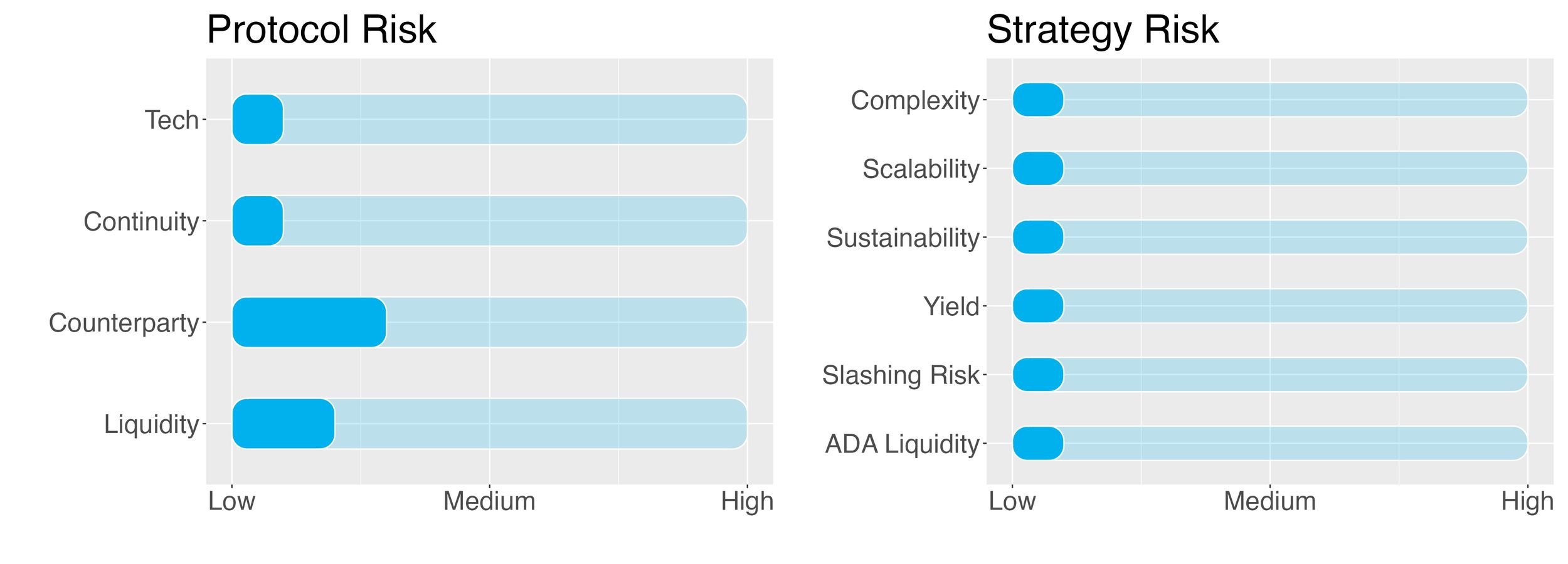Staking

Key Takeaways:
- Staking represents one of the safest options in DeFi to generate a yield.
- We rely only on secure and trustable staking providers
- The Yield (APY) is derived from ADA staking (i.e. contributing to the Proof-of-Stake consensus
mechanism) - The Cardano blockchain has existed since 2015 and, prior to the Merge, was the largest cryptocurrency to use a proof-of-stake consensus mechanism.
- ADA staking represents a very liquid yield-generating investment. There is no lock-up period and funds can be redeemed at any time.
- Risk Checklist: No risk is deemed as a concern for this strategy.
Nevertheless main issues could be related to: Counterparty risk, Protocol liquidity risk and ADA staking liquidity risk
1. Strategy explained
The strategy is fairly simple: deposit ADA on the provider’s staking pool and receive staking rewards.
Lockup period: None. Assets can be redeemed at any time.
2. Risks
Trust Score
Only trustable and sound staking providers with top score from CER are considered.
CER’s cybersecurity ranking is based on a comprehensive methodology that accounts for more than 20 indicators, including server and user security, penetration test, bug bounty, and funds insurance.
At SwissBorg we make sure that these are reliable and battle tested, and adhere to the higherst standard of security.
SwissBorg trust score for employed staking protocols is ‘green’, meaning they are trustworthy.
Protocol Risks
Project Continuity Risk
Overall Continuity Risk is deemed low.
Only top staking providers with reputable history of service are selected. This minimizes the risks of continuity issues which would require the staking activity to be moved to a new provider.
Project continuity risk is set to 1/10.
Counterparty Risk
Overall Counterparty risk is deemed low.
Counterparty risk exists whenever an asset it handed over to an external provider. Any credit event involving the staking provider could affect the asset we have entrusted him with.
This said, staking via a 3rd party it is fundamentally different from depositing funds in a lending protocol that became insolvent.
We seek to select only trustable staking providers in order to minimise the counterparty risk.
Counterparty risk is set to 3/10.
Liquidity Risk
Liquidity Risk is deemed low.
Funds held by the staking provider are redeemable at any time (unless differently agreed upon).
It could still be that due to very adverse market conditions some of the providers’ funds are under pressure and, although an unlikely event, this could pose liquidity constraints on the platform.
Liquidity risk is 3/10.
Strategy Risk
Complexity
Complexity of strategy is low.
The strategy involves depositing ADA which is used for staking purposes, i.e. to validate the transactions on the Cardano network.
Staking is the most basic form of yield generating strategy in crypto.
Complexity of the strategy is 1/10.
Scalability
Scalability risk of strategy is low.
Staking is a highly scalable practice. Indeed, the more the stakers, the higher the safety of the blockchain.
Scalability risk of the strategy is 1/10.
Sustainability
Sustainability risk of strategy is low.
The yield obtained from this strategy is fully sustainable as it comes from participating in the validation of Cardano transactions (Proof of Stake mechanism).
Proof-of-Stake is not energy intensive (as opposed to Proof-of-Work chains like Bitcoin) and has therefore virtually no negative impact on the environment.
Sustainability risk of the strategy is 1/10.
Yield Risk
Yield risk of strategy is low.
Staking provinces a constant stream of income with low variability.
Yield risk of the strategy is 1/10.
Slashing Risks
Slashing risk on Cardano is low.
The Proof of Stake consensus mechanism requires participants to behave responsibly for the overall good of the ecosystem. For this reason, blockchains penalise validators if they step out of line, by slashing the value of their stake. The two most common offenses are double-signing or going offline when the validator should be available to confirm a new block.
The best protection against these risks is to work with an institutional-grade validator that protects against double-signing and downtime.
Cardano is, however, different. Cardano does not need slashing since it has a unique reward-sharing scheme that supports a high level of decentralisation in the environment where all stakeholders are economically incentivised to behave rationally.
The protocol economically incentivises the existence of the desired number of pools in a way so that it is irrational to behave maliciously and it can be expected that irrational participants will form only a marginal group. When a majority of ADA coins are in the hands of rational participants then the irrational ones have low power.
The security of Cardano grows with the distribution of ADA coins.
Slashing risk is 1/10.
Liquidity Risks of staking
Liquidity Risk on staking ADA is low.
Most staking opportunities require the investor to lock their tokens for an agreed period, from hours to days, or even months. Whichever way the market turns during this time, your assets will be out of reach.
In staking however stakes are added to a liquidity pool and redeemable at any time. This is also the case with staking on ADA.
Liquidity risk is therefore set to 1/10.
3. Conclusions/Recommendations
ADA staking comes with little risks.
Only trustable and sound staking providers with top score from CER are considered.CER’s cybersecurity ranking is based on a comprehensive methodology that accounts for more than 20 indicators, including server and user security, penetration test, bug bounty, and funds insurance.
The yield (APY) comes from securing transactions on the Cardano blockchain, with ADA being its native cryptocurrency. The Cardano project was founded in 2015 by Charles Hoskinson, co-founder of Ethereum, and, prior to the Merge, was the largest cryptocurrency to use a proof-of-stake consensus mechanism (i.e. environmental friendly).
Last, ADA staking represents a very liquid yield-generating investment with no luck-up periods and available redemption at any time.
The SwissBorg Risk Team ranks ADA staking as a Low risk investment, one for an investor with some understanding of DeFi and yielding, who is willing to take on a minimum amount of risk (remember, there is no free lunch!) in exchange for an acceptable reward on ADA.
Try the SwissBorg Earn today!






